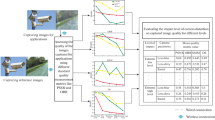Abstract
This paper discusses exposure determination for digital cameras, beginning with a tutorial on exposure control and the factors affecting the quality of still captures, especially exposure index. It presents a psychometric model for the overall quality of digital camera images as a function of motion blur and exposure index. A motion-aware exposure control algorithm based on that model is described for exclusively ambient illumination and then extended for combined flash and ambient illumination. Results from a field test with a modified consumer camera quantify the effectiveness of the algorithm.














Similar content being viewed by others
Notes
Based on the square root of the number of photo-electrons, accounting for Poisson noise and ignoring all other noise sources.
Values of zero motion blur were replaced with 0.1 pixels of motion blur, to avoid logs of zero.
Computed by averaging log EI values, rather than EI values.
Exposure decisions can only be made along Exposure Determination lines, so sliding the Peak Quality curve right also slides it down, and sliding it left also slides it up.
This threshold would typically be between 0.1 and 0.25 log2 pixels of blur.
References
Park, S., Kim, G., & Jeon, J. (2009). The method of auto exposure control for low-end digital camera. In 11th international conference on advanced communication technology, 2009. ICACT 2009 (Vol. 3, pp. 1712–1714).
Murata, H., & Okino, T. (2005). Camera apparatus with exposure correction based on movement of the object. U.S. Patent application number 200549930A.
Pillman, B. (2010). Camera exposure determination based on a psychometric quality model. In IEEE 2010 workshop on signal processing systems (SIPS) (pp. 339–344).
Photography—digital still cameras - determination of exposure index, iso speed ratings, standard output sensitivity, and recommended exposure index. (2006). Tech. Rep. ISO 12232:2006, ISO TC42/WG 18.
Keelan, B. W. (2002). Handbook of image quality, New York, USA: Marcel Dekker.
Photography—psychophysical experimental methods for estimating image quality—part 3: Quality ruler method. (2005). Tech. Rep. ISO 20462-3:2005, ISO TC42.
Acknowledgements
The authors thank two co-workers at Eastman Kodak Company, David B. Goldstein for photoshoots, and Ann Marie Taccardi for extensive discussion, editing and proofreading.
Author information
Authors and Affiliations
Corresponding author
Rights and permissions
About this article
Cite this article
Pillman, B., Jasinski, D. Camera Exposure Determination Based on a Psychometric Quality Model. J Sign Process Syst 65, 147–158 (2011). https://doi.org/10.1007/s11265-011-0612-z
Received:
Revised:
Accepted:
Published:
Issue Date:
DOI: https://doi.org/10.1007/s11265-011-0612-z




